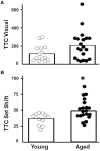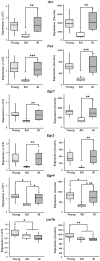Transcription Profile of Aging and Cognition-Related Genes in the Medial Prefrontal Cortex
- PMID: 27242522
- PMCID: PMC4868850
- DOI: 10.3389/fnagi.2016.00113
Transcription Profile of Aging and Cognition-Related Genes in the Medial Prefrontal Cortex
Abstract
Cognitive function depends on transcription; however, there is little information linking altered gene expression to impaired prefrontal cortex function during aging. Young and aged F344 rats were characterized on attentional set shift and spatial memory tasks. Transcriptional differences associated with age and cognition were examined using RNA sequencing to construct transcriptomic profiles for the medial prefrontal cortex (mPFC), white matter, and region CA1 of the hippocampus. The results indicate regional differences in vulnerability to aging. Age-related gene expression in the mPFC was similar to, though less robust than, changes in the dorsolateral PFC of aging humans suggesting that aging processes may be similar. Importantly, the pattern of transcription associated with aging did not predict cognitive decline. Rather, increased mPFC expression of genes involved in regulation of transcription, including transcription factors that regulate the strength of excitatory and inhibitory inputs, and neural activity-related immediate-early genes was observed in aged animals that exhibit delayed set shift behavior. The specificity of impairment on a mPFC-dependent task, associated with a particular mPFC transcriptional profile indicates that impaired executive function involves altered transcriptional regulation and neural activity/plasticity processes that are distinct from that described for impaired hippocampal function.
Keywords: aging; cognitive flexibility; prefrontal cortex; set shifting task; transcription.
Figures









Similar articles
-
Hippocampal Subregion Transcriptomic Profiles Reflect Strategy Selection during Cognitive Aging.J Neurosci. 2020 Jun 17;40(25):4888-4899. doi: 10.1523/JNEUROSCI.2944-19.2020. Epub 2020 May 6. J Neurosci. 2020. PMID: 32376783 Free PMC article.
-
DNA Methylation of Synaptic Genes in the Prefrontal Cortex Is Associated with Aging and Age-Related Cognitive Impairment.Front Aging Neurosci. 2017 Aug 2;9:249. doi: 10.3389/fnagi.2017.00249. eCollection 2017. Front Aging Neurosci. 2017. PMID: 28824413 Free PMC article.
-
Prefrontal cortical GABAergic signaling and impaired behavioral flexibility in aged F344 rats.Neuroscience. 2017 Mar 14;345:274-286. doi: 10.1016/j.neuroscience.2016.02.014. Epub 2016 Feb 9. Neuroscience. 2017. PMID: 26873002 Free PMC article.
-
Differential Rearrangement of Excitatory Inputs to the Medial Prefrontal Cortex in Chronic Pain Models.Front Neural Circuits. 2021 Dec 24;15:791043. doi: 10.3389/fncir.2021.791043. eCollection 2021. Front Neural Circuits. 2021. PMID: 35002635 Free PMC article. Review.
-
Role of the thalamic nucleus reuniens in mediating interactions between the hippocampus and medial prefrontal cortex during spatial working memory.Front Syst Neurosci. 2015 Mar 10;9:29. doi: 10.3389/fnsys.2015.00029. eCollection 2015. Front Syst Neurosci. 2015. PMID: 25805977 Free PMC article. Review.
Cited by
-
Dietary Restriction and Rapamycin Affect Brain Aging in Mice by Attenuating Age-Related DNA Methylation Changes.Genes (Basel). 2022 Apr 15;13(4):699. doi: 10.3390/genes13040699. Genes (Basel). 2022. PMID: 35456505 Free PMC article.
-
Age and Ketogenic Diet Have Dissociable Effects on Synapse-Related Gene Expression Between Hippocampal Subregions.Front Aging Neurosci. 2019 Sep 13;11:239. doi: 10.3389/fnagi.2019.00239. eCollection 2019. Front Aging Neurosci. 2019. PMID: 31607897 Free PMC article.
-
Age and Sex Influence the Hippocampal Response and Recovery Following Sepsis.Mol Neurobiol. 2019 Dec;56(12):8557-8572. doi: 10.1007/s12035-019-01681-y. Epub 2019 Jul 5. Mol Neurobiol. 2019. PMID: 31278440 Free PMC article.
-
Sexually dimorphic extracellular vesicle responses after chronic spinal cord injury are associated with neuroinflammation and neurodegeneration in the aged brain.J Neuroinflammation. 2023 Aug 31;20(1):197. doi: 10.1186/s12974-023-02881-z. J Neuroinflammation. 2023. PMID: 37653491 Free PMC article.
-
Adar3 Is Involved in Learning and Memory in Mice.Front Neurosci. 2018 Apr 13;12:243. doi: 10.3389/fnins.2018.00243. eCollection 2018. Front Neurosci. 2018. PMID: 29719497 Free PMC article.
References
Grants and funding
LinkOut - more resources
Full Text Sources
Other Literature Sources
Molecular Biology Databases
Miscellaneous

